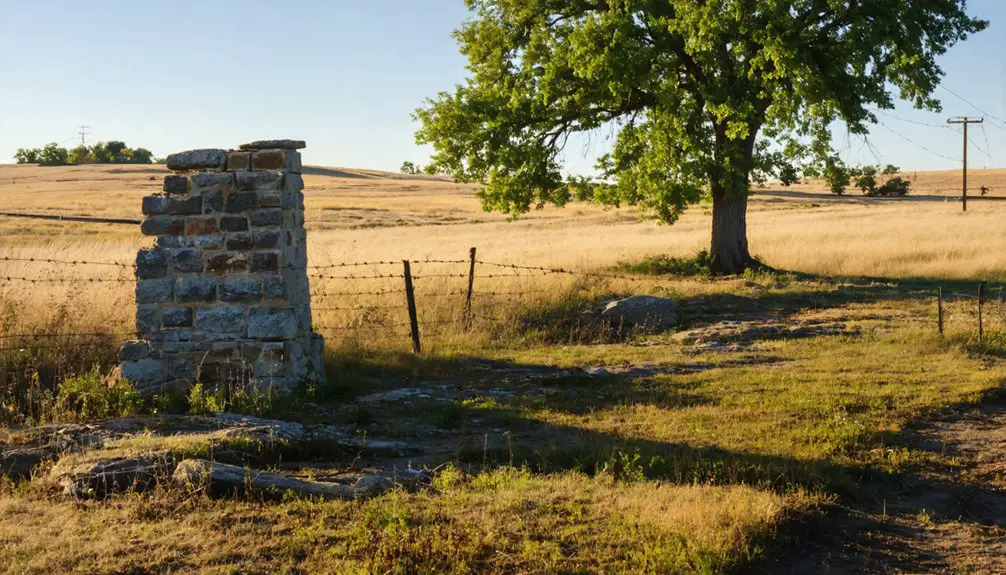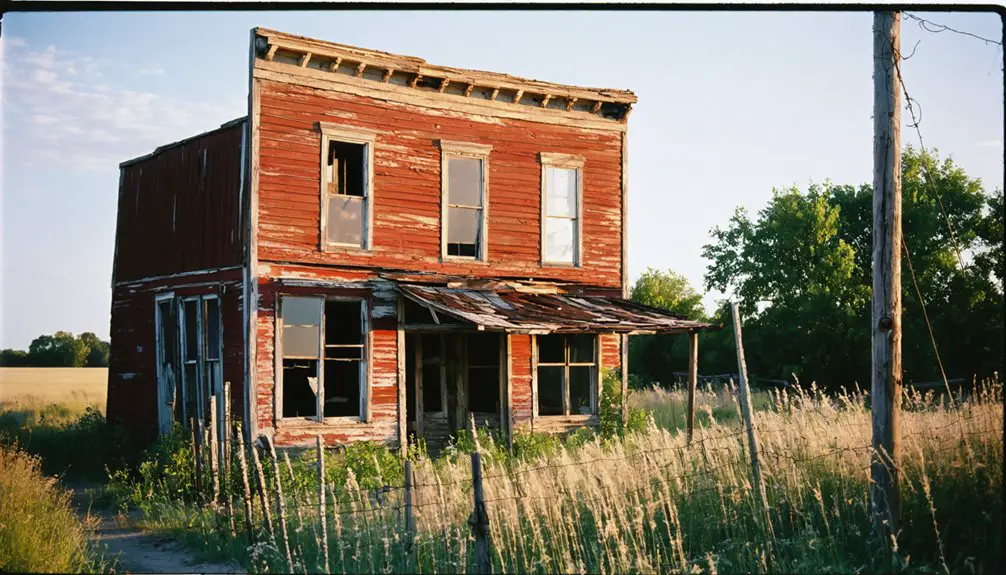You’ll find Pardee’s remnants in Atchison County, Kansas, where this ghost town began as a Free-State stronghold in the 1850s. Named after abolitionist minister Pardee Butler, who claimed 160 acres in 1855, the settlement became a sanctuary for anti-slavery settlers during the tumultuous Bleeding Kansas era. While the town thrived initially with river trade and railroad connections, its decline began with the post office’s closure in 1903. The old Mt. Pleasant Church still stands as a symbol of its pioneering spirit.
Key Takeaways
- Pardee, Kansas was a Free-State settlement established in the 1850s that declined significantly after its post office closed in 1903.
- The town was named after abolitionist Reverend Pardee Butler, who claimed 160 acres and established the first Church of Christ in Kansas.
- Mt. Pleasant Church and its adjacent cemetery remain as the primary historical landmarks of this former thriving river town.
- Economic decline occurred due to railroad competition, agricultural mechanization, and the growing dominance of nearby towns like Atchison and Sumner.
- The town’s ghost status is marked by its abandoned structures, with the 1947 church building being the oldest surviving structure.
The Birth of a Free-State Settlement
As tensions escalated throughout Kansas Territory in the mid-1850s, the settlement of Pardee emerged as a determined Free-State stronghold twelve miles west of Atchison. Named after abolitionist minister Pardee Butler, who claimed 160 acres in 1855, the community quickly became a sanctuary for those opposing slavery‘s expansion under the Kansas-Nebraska Act.
Amidst the struggle over slavery in Kansas Territory, Pardee stood defiantly as a beacon of freedom and resistance against oppression.
You’ll find Pardee’s history deeply rooted in the Free State legacy, as Quaker settlers from Iowa joined Butler’s cause, establishing a powerful anti-slavery presence. Despite facing violent mob attacks, Butler’s unwavering commitment to the Free-State movement inspired the growing settlement. Like other Free-Soilers before him, Butler endured cruel humiliation when he was set adrift on a raft down the Missouri River.
The community centered around the Mt. Pleasant Church, also known as Round Prairie Church, where Duke Young helped organize the first Church of Christ in Kansas by 1856.
Through religious gatherings and determined resistance, Pardee’s early settlers transformed what was once pro-slavery territory into a crucial Free-State settlement.
Reverend Pardee Butler’s Lasting Impact
While facing violent persecution from pro-slavery mobs, Reverend Pardee Butler‘s unwavering commitment to abolition left an indelible mark on Kansas Territory’s path to freedom. Despite being set adrift on the Missouri River and facing repeated banishment attempts, his community resilience shone through as he returned time and again to champion the free-state cause.
You’ll find Butler’s abolitionist legacy woven throughout Atchison County’s early development. As a founding Republican Party organizer and Restoration Movement preacher, he established the Mt. Pleasant Church – Kansas’ first Church of Christ – in 1856. After acquiring 160 acres near Atchison, he became the first Christian minister to preach in Kansas Territory in June 1855. Coming from a family of New England settlers, his commitment to religious and social reform was deeply rooted in his upbringing.
His influence extended beyond the pulpit, combining farming with ministry while actively confronting pro-slavery political forces. Even after his death, the church locations and his burial site stand as historical landmarks, evidence of his enduring impact on Kansas’ free-state journey.
Life During the Bleeding Kansas Era
During the turbulent period known as Bleeding Kansas, settlers in towns like Pardee faced constant threats of violence from three warring factions: pro-slavery advocates, Free-Staters, and abolitionists.
You’d find your neighbors arming themselves while community resilience was tested by raids, arson, and political killings. Daily life became a struggle as social networks fractured under the weight of suspicion and fear.
You couldn’t trust local law enforcement, which was often biased or ineffective, forcing many settlers to join militias for protection. The Kansas-Nebraska Act of 1854 had unleashed this violent competition between pro-slavery and anti-slavery settlers. The threat of pro-slavery “border ruffians” from Missouri loomed large, while violent incidents like the Pottawatomie Creek massacre and the Sack of Lawrence sent shockwaves through Kansas communities. John Brown’s Christmas Raid in 1858 further intensified tensions as he led abolitionists in freeing enslaved people from Missouri.
Many families had to relocate repeatedly, seeking safety as the territory descended into guerrilla warfare.
Economic Rise and Fall
Beyond the political violence of Bleeding Kansas, Pardee’s early economic story followed a path common to many Kansas settlements. You’d have found the town thriving initially through agriculture and local commerce, bolstered by federal policies like the Homestead Acts that created economic opportunities for settlers willing to work the land.
But you wouldn’t recognize Pardee today. Like over 6000 dead towns across Kansas, Pardee’s decline mirrored the broader rural decline that swept across Kansas. As farming became mechanized, fewer workers were needed in the fields. The presence of Walmart within reach accelerated the downward spiral of local businesses.
When larger corporations began dominating markets and big-box stores opened in nearby towns, Pardee’s small businesses couldn’t compete. Transportation shifts dealt another blow, as new highways redirected traffic and commerce away from the community.
Global market pressures and agricultural consolidation eventually pushed the town past its breaking point.
Notable Buildings and Landmarks
When you visit Pardee today, you’ll find its most prominent landmark is the church built around 1947, which stands as the oldest surviving structure in the ghost town.
At one point, Pardee’s post office operated from various homes and buildings between 1858 and 1904, though none of these original postal structures remain. Like many small Kansas communities affected by Wichita’s growth, the town gradually lost its population and infrastructure over time. Similar to the town of Chelsea, daily stagecoach service connected Pardee to neighboring communities.
The pioneer church, featuring an adjacent cemetery, has outlasted all other early community buildings to become the town’s primary historical marker.
Early Post Office History
As Pardee established itself in territorial Kansas, the community’s first post office operated initially in nearby Ocena under postmaster William Crosby in August 1855.
The post office evolution shifted in 1858 when operations moved to Pardee, reflecting the town’s growing significance as a communication infrastructure hub.
Under the oversight of postmaster S. G., the Pardee post office served as a crucial link to the outside world during the politically charged territorial period.
You’ll find its importance heightened by the presence of Reverend Pardee Butler, the town’s namesake and prominent abolitionist preacher, who relied on postal services to maintain connections despite facing violent opposition in nearby Atchison.
The post office continued operations for 45 years until its closure in 1903, marking the beginning of Pardee’s decline.
Pioneer Church Structures
Standing as a tribute to pioneer religious life, the Farmington Christian Church remains the most significant historic structure in Pardee. Built around 1897, nine years after Pardee Butler’s death, this example of pioneer architecture features a southeast-facing sanctuary entrance and a single stained glass window on its eastern wall.
The church’s deteriorating condition has sparked urgent restoration needs, with its siding, doors, and window frames requiring significant repairs. You’ll find the pulpit positioned in the sanctuary’s northern section, while structural concerns include a shifting basement wall and compromised ceiling beneath the steeple.
Like many frontier churches, its construction followed extensive community fundraising efforts, with local women actively gathering subscriptions to support this enduring symbol of Kansas pioneer spirit.
From Bustling Town to Abandonment
Despite its promising beginnings as a river town in the 1850s, Pardee’s journey from bustling settlement to abandonment unfolded gradually over several decades.
You’d have found a thriving community built around river trade, with Caleb May’s general store and a post office serving as central gathering points. The town’s location along the Atchison, Topeka & Santa Fe railroad initially bolstered its prospects.
However, you’ll see how community dynamics shifted as nearby Atchison and Sumner grew more dominant. By the early 1900s, changing transportation patterns and agricultural mechanization diminished Pardee’s relevance.
The post office’s closure in 1903 marked a turning point, signaling the town’s declining population.
Today, you won’t find any remaining structures in what’s now classified as a ghost town.
Historical Significance in Atchison County

You’ll find Pardee’s most enduring legacy in its role as an anti-slavery stronghold during Kansas’s territorial period, where the town’s namesake Pardee Butler established influential religious and abolitionist foundations.
Despite facing violent opposition, including being tarred and feathered in nearby Atchison, Butler’s persistent activism helped shape the region’s anti-slavery sentiment through his ministry and the establishment of Kansas’s first Church of Christ.
The town’s strategic location, about 6-12 miles west of Atchison, positioned it as an essential hub for abolitionist organizing during the tumultuous Bleeding Kansas era, contrasting sharply with pro-slavery settlements in the area.
Abolitionist Movement Impact
While the nation grappled with slavery in the 1850s, Atchison County emerged as a crucial battleground in the abolitionist movement, largely through the efforts of Reverend Pardee Butler.
As a fearless advocate for freedom, Butler’s abolitionist strategies included organizing Republican Party meetings and delivering powerful anti-slavery speeches, despite facing violent opposition from pro-slavery groups who once set him adrift on the Missouri River.
The movement’s impact created deep community division in Pardee and throughout Atchison County, with some residents secretly supporting the anti-slavery cause while others openly opposed it.
Butler’s influence extended beyond politics, helping establish churches and institutions that advanced abolitionist ideals.
His actions ultimately contributed to Kansas entering the Union as a free state, cementing the region’s role in America’s path toward emancipation.
Early Settlement Tensions
As Kansas Territory erupted in conflict during the mid-1850s, the settlement of Pardee emerged as a flashpoint between pro-slavery and free-state forces in Atchison County. The tensions you’d witness there reflected the broader “Bleeding Kansas” struggles, with free state resistance centered in Pardee facing intense opposition from proslavery tensions in nearby Atchison.
- Rev. Pardee Butler and Caleb May established the town as a haven for abolitionists in 1857.
- Proslavery “border ruffians” from Atchison violently targeted free-state settlers, particularly tarring and feathering Butler.
- The Christian Church served as a rallying point for anti-slavery activists.
- Daily life became increasingly dangerous as hostilities disrupted the community’s growth.
The stark divide between Pardee’s abolitionists and Atchison’s pro-slavery factions would ultimately shape the settlement’s destiny.
Frequently Asked Questions
What Native American Tribes Originally Inhabited the Pardee Area?
You’ll find the Kansa (Kaw) tribe dominated this area’s tribal history, while Osage and Pawnee people also claimed cultural significance here. The Shawnee established nearby farming communities too.
Were There Any Major Epidemics or Natural Disasters in Pardee’s History?
Despite 45 years of settlement history, you won’t find records of major epidemic impact or disaster recovery in Pardee’s chronicles. The town’s main struggles centered on social and political conflicts instead.
What Crops and Livestock Were Primarily Raised by Pardee’s Farming Community?
You’ll find crop diversity centered on corn, wheat, oats, and potatoes, while livestock management focused on cattle, hogs, horses, and chickens. Sheep and hay production supported farm operations.
Did Any Famous Outlaws or Lawmen Ever Visit Pardee?
While famous visitors and outlaw legends roamed Kansas Territory, you won’t find evidence of notorious outlaws or lawmen in Pardee’s history. The town’s reputation centered on abolition, not frontier justice.
What Happened to the Cemetery and Burial Records From Pardee?
You’ll find limited details about Pardee Cemetery’s preservation, but it’s still located in Cummings, Kansas. Your search for burial documentation might lead to FamilySearch records or local historical societies.
References
- https://en.wikipedia.org/wiki/Pardee
- https://www.kspatriot.org/index.php/articles/56-kansas-local-history/754-towns-past-and-present-of-atchison-county.html
- https://www.youtube.com/watch?v=VPZtNoncnig
- https://kids.kiddle.co/Pardee
- https://www.ksgenweb.org/archives/1912/p/pardee.html
- https://legendsofkansas.com/pardee-butler/
- https://www.therestorationmovement.com/_states/kansas/butler
- https://www.nps.gov/npgallery/GetAsset/5c8a5ce2-d40d-4a57-bbef-703aac0b479c
- http://www.kancoll.org/books/cutler/atchison/atchison-co-p3.html
- https://www.gutenberg.org/files/12973/12973-h/12973-h.htm



